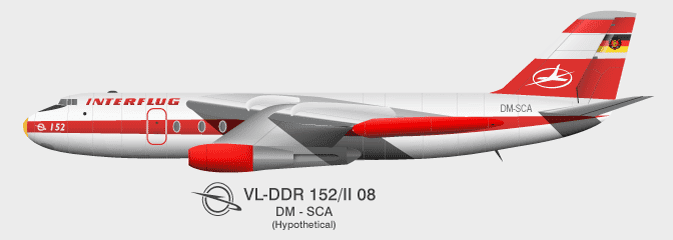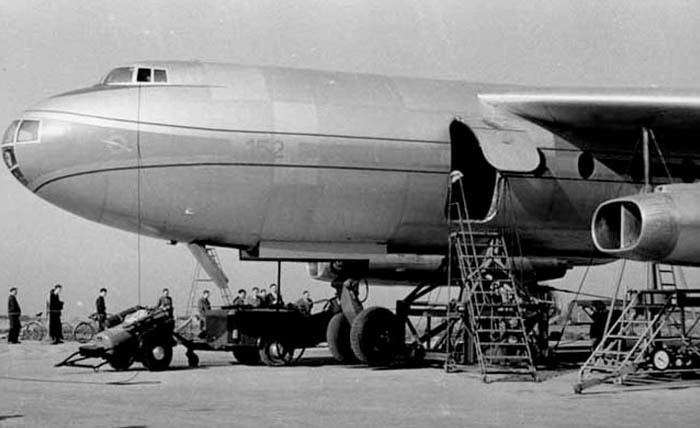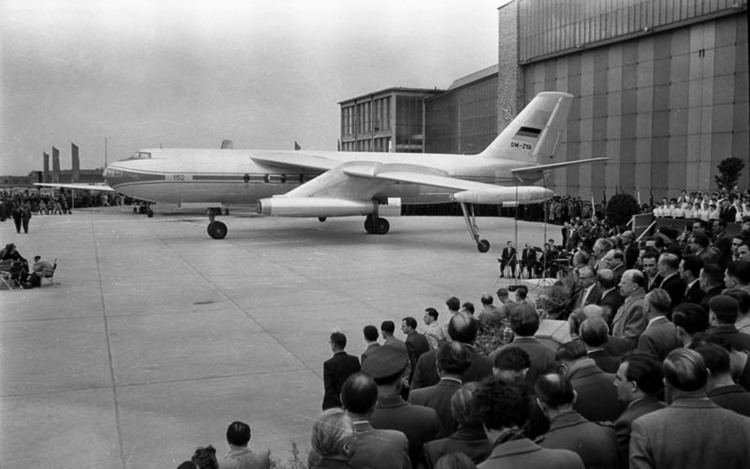Top speed 920 km/h Length 31 m First flight December 4, 1958 | Wingspan 26 m Retired 1961 | |
 | ||
Baade 152 jetliner promo film 1960
The Baade 152 also known as Dresden 152, VL-DDR 152 or simply 152 was the first German jet passenger airliner. It was built and tested in Dresden (East Germany) between 1956 and 1961, but failed to enter service. The "152" represents the final development in the Junkers aircraft family which ended with the "development planes" (Entwicklungsflugzeug - EF).
Contents

Design and development

The aircraft was named after the designer of the plane, Brunolf Baade. Only three airworthy prototypes were built; two of them were flown on three flights. The first prototype V1/I (DM-ZYA) was derived from the Samoljot 150 or Alekseyev 150 jet bomber designed by former Junkers engineers in the Soviet Union. It included a tandem landing gear and glazed nose for the navigator, which was a common feature in many Eastern Bloc aircraft. The 152's landing gear was unusual for a passenger plane in that the main gear was housed along the centerline of the fuselage with outrigger wheels in the wing-tips (similar to the more well-known Boeing B-47). The tail of the airplane was tested on a propeller driven aircraft, the Soviet Il-14, which was built under license in East Germany.

The maiden flight of this aircraft took place 4 December 1958 and lasted 35 minutes. The aircraft was lost on its second flight in a crash at Ottendorf-Okrilla on 4 March 1959, killing the entire crew. The reasons for the crash were never fully investigated and the results of the limited investigation were only made public in 1990.

Test flights continued with the second prototype V4/II (DM-ZYB). This second prototype had a different landing gear configuration, with an unusual configuration of the main landing gear sharing the same pylon as the engines. This aircraft also had abandoned the glazed nose for the navigator.
The third prototype, V5/II (DM-ZYC), served only ground tests.

The flight testing came to an abrupt end after only three flights, when a serious malfunction in the fuel tanks, interrupting sufficient fuel supply during steep descent, was discovered. The question of whether this design flaw contributed to the crash of the first prototype is still unanswered. There were still about 20 aircraft in production for the East German state airline Deutsche Lufthansa until mid-1961. At this time, the East German government stopped all aeronautical industry activities, as the Soviet Union which promoted its own design, the Tu-124, did not want to buy any of these aircraft or support any further development.
All examples of the aircraft were scrapped, though currently there is a restoration of the abandoned 152/II #011 fuselage, which was begun in 1995 at EADS EFW (Elbe Flugzeugwerke GmbH) in Dresden, which is the direct successor of VEB Flugzeugwerke Dresden.
The Industriewerke Ludwigsfelde (IWL) near Berlin made the Pirna 014 engines, and was left with 30 completed engines after the project was cancelled. These were later used to power minesweepers for the Volksmarine.
Chronology
Specifications (152/II V4)
Data from 152 Homepage
General characteristics
Performance
